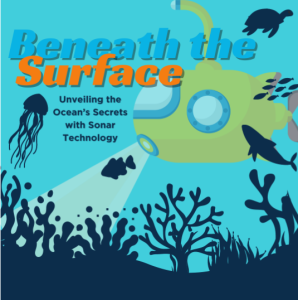Beneath the Surface: Unveiling the Ocean’s Secrets with Sonar Technology
By Bianca Loglisci, C2ST Intern, Loyola University
Even though the ocean makes up 70% of our planet’s surface, most of it remains unexplored. With depths of up to 12,000 feet and a total surface area of 139 million square miles, the global ocean is truly enormous and may hold mysteries beyond human comprehension. I have always been fascinated by the mysteries of the ocean, but after a recent visit to the Field Museum’s new Unseen Oceans exhibit, I started to wonder what methods scientists are using to uncover these mysteries. Thanks to satellite imaging, we have a rough idea of what the ocean floor looks like, however, specific objects like shipwrecks and certain geographic formations are unable to be detected in this way. Scientists have precisely mapped the ocean floor with a scientific technique that utilizes sonar technology, which can help to create a much clearer picture of what lies beneath the surface.

Sonar is short for “Sound Navigation and Ranging” and uses sound waves to detect objects that may not be visible to us. In most cases, the ocean floor is pitch black because sunlight can’t reach that deep. Scientists have begun using sound waves for ocean exploration because sound waves can travel farther in water than radio and light waves. Animals, like dolphins and bats, also use sound waves to detect objects around them; some underwater sonar technology has even been inspired by dolphins. Usually, sonar technology is attached to a boat, underwater vessel, or marine robot and collects data as it moves through the water.
Sonar technology can either be active or passive. Active sonar technology works by emitting sound waves via a transmitter. These sound waves bounce off of surrounding objects and return to their source. A receiver picks up the signal and uses a complex system of computer programs and hardware to measure the time it took for the sound wave to return and the distance it had to travel before hitting an object. Unlike active sonar systems, passive sonar systems do not emit their own sound waves. Instead, they pick up the sound waves created by other objects or organisms using a receiver. Active sonar systems are used more often for ocean floor mapping than passive systems because passive systems require multiple different systems working at once to measure distance, while active systems only need one. Using data collected by sonar technology, scientists can more accurately determine what the ocean floor looks like and what objects and landforms exist outside our view.
So far, about 25% of the seafloor across the globe has been mapped in detail, and with 75% more left unseen, scientists are still hard at work utilizing sonar technology to make discoveries. New data is being collected every day, but what can we use this data for? Having detailed information about the seafloor can tell us a lot about the potential habitats of marine life, a topic that is also widely unknown. Understanding marine life and its behaviors may lead to inspiration for new technology in the future, much like how the behavior of dolphins inspired some sonar technology. Scientists also believe that a better understanding of the ocean can provide us with more resources such as food, energy, and medicine. In our current climate crisis, resources must be utilized sustainably, so mapping the topography of the ocean floor can potentially provide us with new ways of thinking about how we use our Earth’s resources. Ocean exploration can also be helpful in that it can provide us with more information about the root causes of certain weather patterns and natural disasters like tsunamis and hurricanes, which are often exacerbated by climate change. These are just some of the reasons why scientists are investing time in ocean exploration using sonar technology. There is so much more left to be discovered, and I am looking forward to “hearing” all about it!
References
- https://www.fieldmuseum.org/exhibitions/unseen-oceans
- https://www.nature.com/articles/s44172-022-00010-x
- https://geoscience.blog/diving-into-the-depths-exploring-the-haloclines-impact-on-sonar-technology-in-oceanography/
- https://oceanexplorer.noaa.gov/facts/why.html
- https://oceanexplorer.noaa.gov/facts/explored.html
- https://oceanservice.noaa.gov/facts/sonar.html
- https://bluerobotics.com/learn/a-smooth-operators-guide-to-underwater-sonars-and-acoustic-devices/